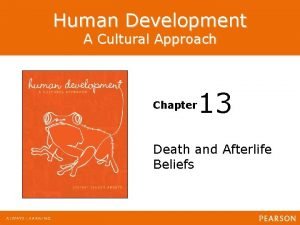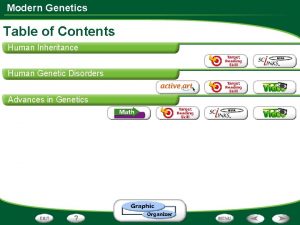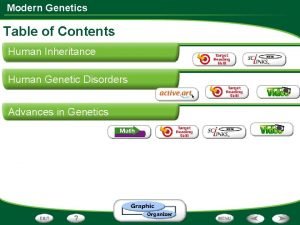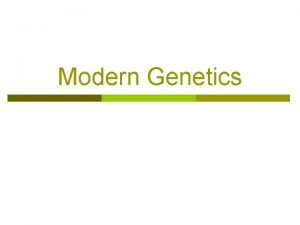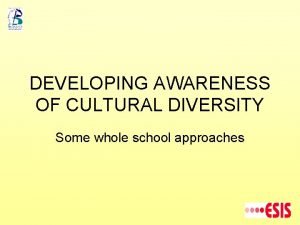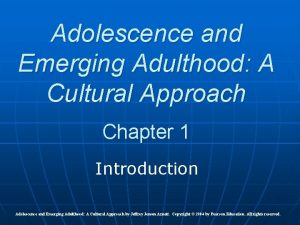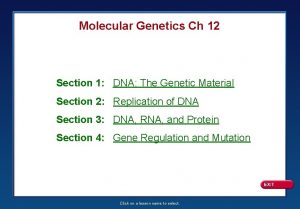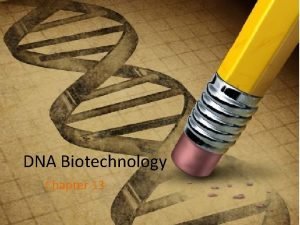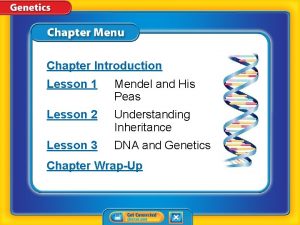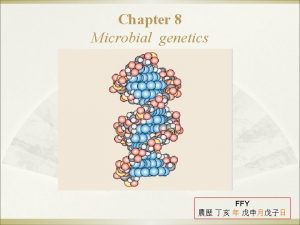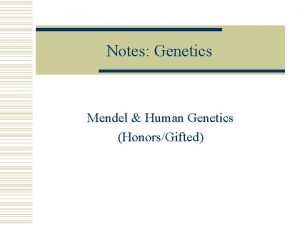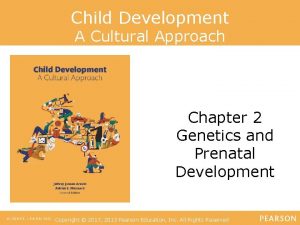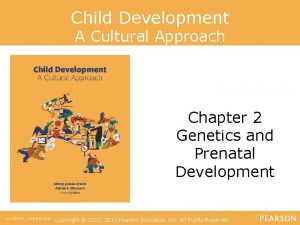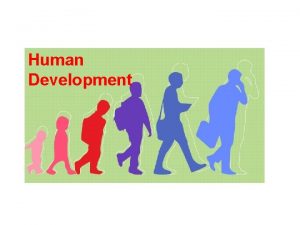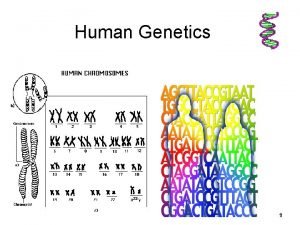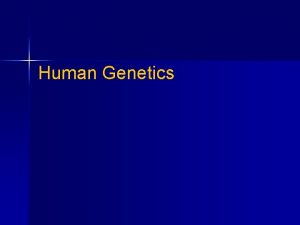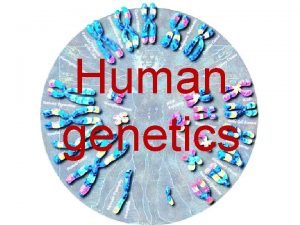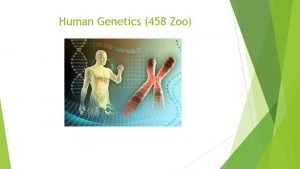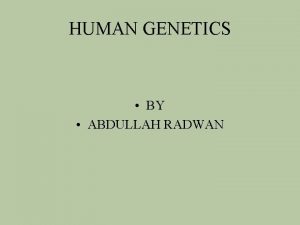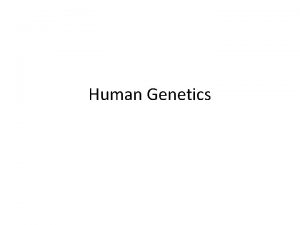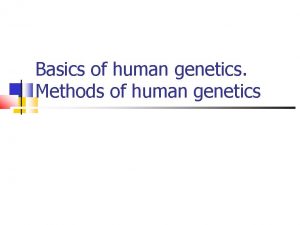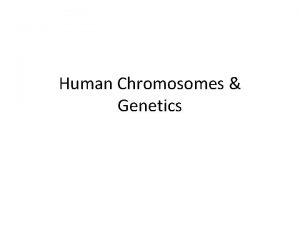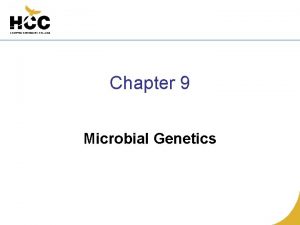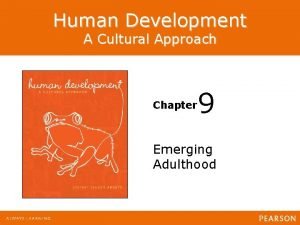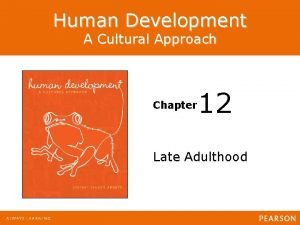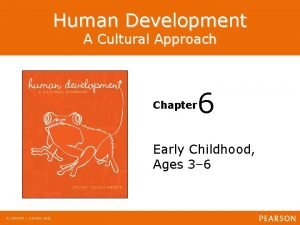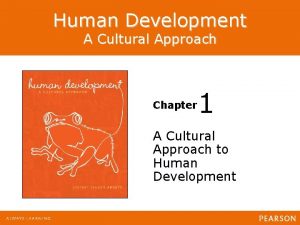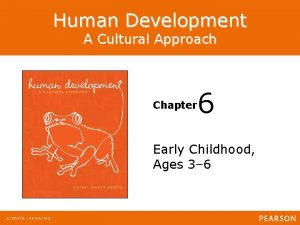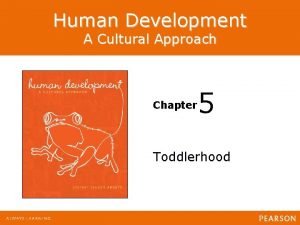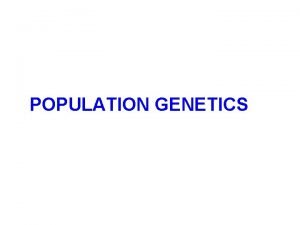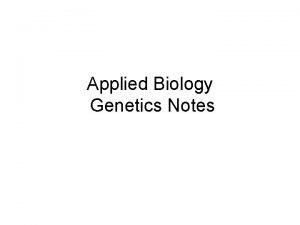Human Development A Cultural Approach Chapter 2 Genetics


































- Slides: 34

Human Development A Cultural Approach Chapter 2 Genetics and Prenatal Development Human Development: A Cultural Approach Jeffrey Jensen Arnett

Genetic Basics Building Blocks of Life • • Chromosomes DNA Genes Genomes Human Development: A Cultural Approach Jeffrey Jensen Arnett

Genetic Basics Expression of Traits • Genotype-The totality of an individual’s genes • Phenotype-Actual Characteristics § This is what is seen or observed and can include a wide range of things Human Development: A Cultural Approach Jeffrey Jensen Arnett

Studies of identical twins illustrate how different factors like smoking, sun exposure, depression and weight gain can influence aging. Age 52. The twin on the left smokes and has a history of more sun exposure, resulting in an older appearance than her twin of the same age. Photo: Dr. Bahman Guyuron Human Development: A Cultural Approach Jeffrey Jensen Arnett

Genetic Basics Expression of Traits • Dominant Genes-Expressed characteristics • Recessive Genes-Not expressed, although it is a part of the genotype (genetic background) Human Development: A Cultural Approach Jeffrey Jensen Arnett

Genetic Basics Genes and Environment • Behavior Genetics § Estimating influence of genes and environment on development § Utilize twins to understand importance of genetics and tease out environment effects Human Development: A Cultural Approach Jeffrey Jensen Arnett

Genetic Basics Genes and Environment • Heritability § An estimate of the extent to which genes are responsible for differences among persons within a specific population • Concordance Rates § Percentage that indicates degree of similarity in phenotype among pairs of family members Human Development: A Cultural Approach Jeffrey Jensen Arnett

The Human Experience Conception and Prenatal Development Human Development: A Cultural Approach Jeffrey Jensen Arnett

Sperm and Egg Formation Cell Division Human Development: A Cultural Approach Jeffrey Jensen Arnett

The Embryonic Period Week 3 -Week 8 • Key Developments § Embryonic Layers - Ectoderm - Mesoderm - Endoderm Human Development: A Cultural Approach Jeffrey Jensen Arnett

The Embryonic Period Week 3 -Week 8 • Key organs and structures are forming including § § § Heartbeat Eyes, nose and mouth Bone development Arm and leg buds Digestive system Human Development: A Cultural Approach Jeffrey Jensen Arnett

The Fetal Period Week 9 -Birth • The longest period of prenatal development § § Heartbeat can be heard Movement can be felt Responds to sounds Main impediment to viability is lung development Human Development: A Cultural Approach Jeffrey Jensen Arnett

The Fetal Period Week 9 -Birth Human Development: A Cultural Approach Jeffrey Jensen Arnett

Prenatal Care Science Driven Prenatal Care • Some current science-driven prenatal methods are derived from traditional cultures which includes massages • Current care can vary by ethnicity and SES • Developing world less likely to receive prenatal care • Current focus on diet, exercise, and teratogens Human Development: A Cultural Approach Jeffrey Jensen Arnett

Map 2. 1 Ethnic Variations in Prenatal Care within the United States How does prenatal care differ for White women compared with other ethnic groups? What economic factors might account for these variations? Human Development: A Cultural Approach Jeffrey Jensen Arnett

Prenatal Care Diet • Two key vitamins are iodine and iron • Iodine deficiency tends to be a bigger issue in developing countries • Iron is necessary for a healthy pregnancy Human Development: A Cultural Approach Jeffrey Jensen Arnett

Prenatal Care Exercise • Continued physical activity is encouraged during pregnancy • Aerobic exercise encourages good cardiovascular health and positively benefits the fetus • A Non-aerobic exercise called Kegel exercises are also encouraged Human Development: A Cultural Approach Jeffrey Jensen Arnett

Prenatal Care Teratogens • Teratogens are environmental and bodily conditions that could be harmful • They can include tobacco, alcohol, prescription medications and other drugs • The physical environment could also be a teratogen due to malnutrition or exposure to hazardous chemicals Human Development: A Cultural Approach Jeffrey Jensen Arnett

Pregnancy Problems Human Development: A Cultural Approach Jeffrey Jensen Arnett

Chromosomal Disorders • Chromosomal disorders can occur because of an issue during meiosis § This may cause too many or too few chromosomes in the cells of the zygote • Two types of chromosomal disorders are: § Sex chromosome disorders § Disorder on the 21 st chromosome (Down Syndrome) Human Development: A Cultural Approach Jeffrey Jensen Arnett

Sex Chromosome Disorders • Sex chromosomal disorder can result from extra X, an extra Y, or only an X and no second chromosome § Common consequences of sex chromosome disorders include: - Cognitive Deficit - Abnormality in reproductive system at puberty Human Development: A Cultural Approach Jeffrey Jensen Arnett

Down Syndrome Trisomy 21 • Identifiable by physical characteristics • Cognitive Deficits § Speech problems § Mental retardation • Social development varies • Lower life expectancy Human Development: A Cultural Approach Jeffrey Jensen Arnett

Parental Age and Chromosomal Disorder • Chromosomal disorders tend to NOT be passed from parent to child • Relationship between maternal age and chromosomal disorders • There may be a relationship between a father’s age and chromosomal disorders but it isn’t as clear Human Development: A Cultural Approach Jeffrey Jensen Arnett

Figure 2. 7 Chromosomal Disorders and Maternal Age Why does the risk rise so steeply after age 40? Source: Reproductive Medicine Associates of New Jersey, 2002 Human Development: A Cultural Approach Jeffrey Jensen Arnett

Teratogens • Major teratogens exist in both developed and developing countries § § Malnutrition Infectious Disease Alcohol Tobacco Human Development: A Cultural Approach Jeffrey Jensen Arnett

Teratogens Timing of Teratogens • Teratogens can impact the developing fetus and embryo at any time • There does appear to be a critical period of prenatal development centered in the embryonic period Human Development: A Cultural Approach Jeffrey Jensen Arnett

Teratogens Timing of Teratogens Human Development: A Cultural Approach Jeffrey Jensen Arnett

Teratogens Malnutrition • Developed countries have food available but may have malnutrition • May be deficient in specific vitamins or improper diet may lead to obesity § Maternal obesity is linked to baby complications • Prenatal nutrition can also cause prenatal problems Human Development: A Cultural Approach Jeffrey Jensen Arnett

Teratogens Drugs-Tobacco • Maternal smoking increases risk of miscarriages, premature birth and low birth weight • Infant effects include difficulty breathing and impaired heart functioning Human Development: A Cultural Approach Jeffrey Jensen Arnett

Teratogens Drugs • Malnutrition and diseases are common in developing countries • Alcohol and tobacco are common in developed countries • Prescription drugs can be damaging • Other teratogens include nonprescription drugs, severe stress, pollution and radiation Human Development: A Cultural Approach Jeffrey Jensen Arnett

Prenatal Diagnosis • Ultrasounds-Uses high frequency sound waves • Amniocentesis-Utilizes amniotic fluid • Chorionic Villus Sampling-Utilizes cells from forming umbilical cord Human Development: A Cultural Approach Jeffrey Jensen Arnett

Figure 2. 9 Fertility and Maternal Age Why does fertility decline after the mid-twenties? Source: Reproductive Medicine Associates of New Jersey, 2002 Human Development: A Cultural Approach Jeffrey Jensen Arnett

Infertility Treatments • Many treatments utilize Assisted Reproductive Technologies (ART) § Artificial Insemination - Injects sperm into woman’s uterus § Fertility Drugs - Mimic hormones involved in ovulation § In-vitro fertilization - Ova removed and fertilized outside the womb then placed into uterus Human Development: A Cultural Approach Jeffrey Jensen Arnett

Map 2. 2 The “Infertility Belt” In certain countries in Central Africa, infertility rates are as high as 30%. The reasons for this are unclear although malnutrition and high rates of STIs are probable factors. Human Development: A Cultural Approach Jeffrey Jensen Arnett
 Human development a cultural approach
Human development a cultural approach Human needs and human development chapter 8
Human needs and human development chapter 8 Chapter 8 human needs and human development
Chapter 8 human needs and human development Human development index definition ap human geography
Human development index definition ap human geography Human inheritance modern genetics answer key
Human inheritance modern genetics answer key Modern genetics human inheritance answer key
Modern genetics human inheritance answer key Modern genetics human inheritance answer key
Modern genetics human inheritance answer key Section 14-3 human molecular genetics
Section 14-3 human molecular genetics Human genetics concepts and applications 10th edition
Human genetics concepts and applications 10th edition Bloodline a human genetics case answer key
Bloodline a human genetics case answer key The cultural approach
The cultural approach Critics who view culture as a map
Critics who view culture as a map A cultural approach to media recognizes
A cultural approach to media recognizes Whole school approach to cultural diversity
Whole school approach to cultural diversity Jeffrey arnett emerging adulthood theory
Jeffrey arnett emerging adulthood theory Chapter 5 diversity and human needs and development
Chapter 5 diversity and human needs and development Chapter 36 section 2 human development before birth
Chapter 36 section 2 human development before birth Infancy psychosocial development
Infancy psychosocial development Mendelian genetics
Mendelian genetics Extending mendelian genetics chapter 7
Extending mendelian genetics chapter 7 Chapter 22 genetics and genetically linked diseases
Chapter 22 genetics and genetically linked diseases Chapter 12 section 1 molecular genetics answer key
Chapter 12 section 1 molecular genetics answer key Chapter 12 molecular genetics
Chapter 12 molecular genetics Chapter 10 section 2 mendelian genetics answer key
Chapter 10 section 2 mendelian genetics answer key Extending mendelian genetics
Extending mendelian genetics Chapter 10 sexual reproduction and genetics
Chapter 10 sexual reproduction and genetics Chapter 12 section 1 the genetic material
Chapter 12 section 1 the genetic material X linked recessive punnett square
X linked recessive punnett square Mendelian genetics vocabulary
Mendelian genetics vocabulary Genetics and biotechnology chapter 13
Genetics and biotechnology chapter 13 Mendel and his peas lesson 1
Mendel and his peas lesson 1 Exogenote
Exogenote Chapter 17 the beginning of the life cycle
Chapter 17 the beginning of the life cycle Difference between datagram and virtual circuit approach
Difference between datagram and virtual circuit approach Theoretical models of counseling
Theoretical models of counseling
